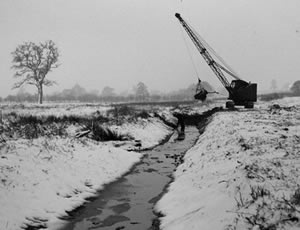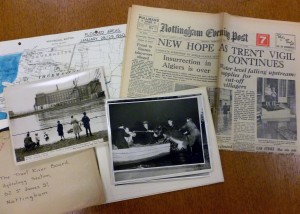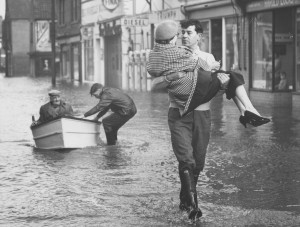December 23, 2011, by Andrew Burden
23 December: Wintry scenes and watery landscapes
 While severe winters are relatively unusual in the UK, last winter’s dramatic cold weather reminded us how lucky we’ve been in recent years.
While severe winters are relatively unusual in the UK, last winter’s dramatic cold weather reminded us how lucky we’ve been in recent years.
The e-Advent calendar blog has already featured Victorian ice-skaters on the River Trent from one particularly cold winter and today’s entry is inspired by this photograph of the River Idle in Nottinghamshire. It was taken in 1963, one of the coldest winters in living memory, when temperatures plummeted to an eye-watering -15 °C.
In an article looking back at some of Nottingham’s coldest winters, The Nottingham Post’s Andy Smart describes conditions in 1963: ‘Blizzards swept across the country; diesel fuel froze in lorry tanks, pipes cracked and sporting events were decimated’. The frozen River Trent even held host to a hockey game between Newark and Burton-on-Trent at Averham Weir.
The snowy 60s…
This video (courtesy of the BBC) shows how the country was transformed into a winter wonderland in 1962/63:
Manuscripts and Special Collections is home to many items concerning extreme weather-related issues such as flooding. Sarah Colborne, Project Archivist for the Water Cataloguing Project, details some of the best ‘weather’ items at the University:
These photographs serve not only to document the changing local landscape, but also provide important data about our changing environment. The papers of hydrologist HR Potter, who worked for the Trent River Board/Authority until c.1975, include some significant files detailing his work for the Authority on researching the cause and effect of the most serious flooding incidents within the Trent catchment area.
Over a hundred water boards, urban councils and corporations in the affected area were contacted by the Trent River Board and requested to send all the information they had on particular weather events. Replies came ‘flooding in’ (sorry!) including data from water level recorders, maps marked up to show waterlogged areas, newspaper articles, and photographs sent in by local freelance photographers and local journals.
The response is comparable to today’s media ‘crowd-sourcing’ of photographs which is often provoked by extremes of weather. The record that is created may have increasing significance for future flood prevention and environmental study.These files are being catalogued thanks to funding awarded by the National Cataloguing Grants scheme, administered by The National Archives, in order to make the University’s regionally and nationally important resource for the study of water available to a wider audience.

Maps, newspapers and photographs (includes the rescue of a donkey from the River Trent) recording the 1960 floods, from the papers of HR Potter.
You can read about our progress on the Water Records Project and we will continue to keep you updated on our discoveries in the files of Harold Potter in our blog postings. An introduction to our holdings relating to water is available on the Manuscripts and Special Collections website.
All of the items featured in our e-Advent calendar are from the University’s historic library holdings, held in Manuscripts and Special Collections. For more information on the wide range of materials available, take a look at their website and blog or contact the curators on mss-library@nottingham.ac.uk
![]()
Find out more about our Manuscripts development plans and how you can support us via the Impact Campaign website.


This is fabulous archive footage with great ‘period’ music. I can remember the snow coming up over the top of my wellies that year …!
[…] va di pari passo con l’ironia nella vita di molte delle persone che vivono lungo questi canali, il loro senso estetico, la recirca di un bello e di un necessario spesso davvero incomprensibili. […]